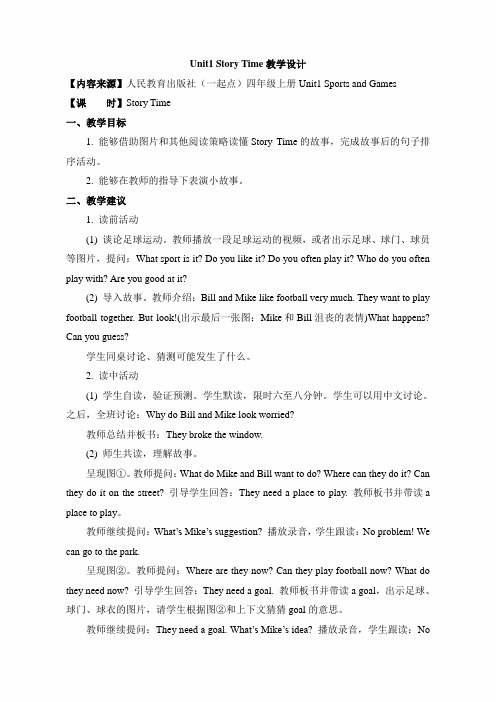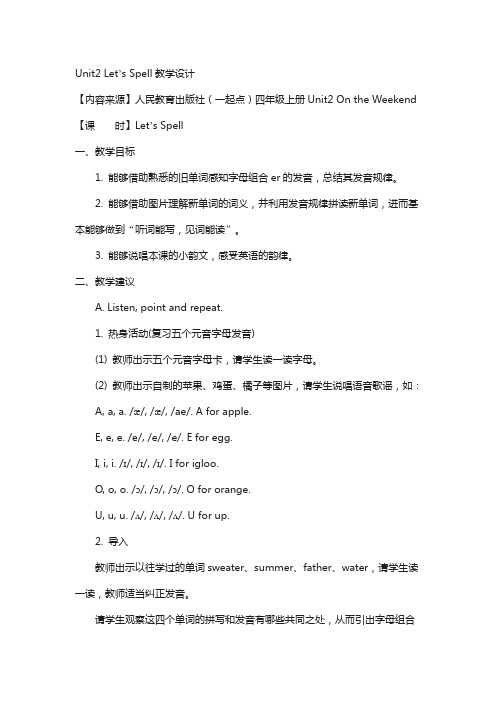人教版新起点英语四年级上册 全册教学设计 教学设计.doc
- 格式:doc
- 大小:74.55 KB
- 文档页数:8


人教版(新起点)四年级英语上册教案设计《Revision1(Let’s Review)》【内容来源】人民教育出版社(一起点)四年级上册Revision1 【课时】LetsReview一、教学目标1.能够比较熟练地听、说、读、写第一至三单元的重点词汇。
2.能够听懂有关第一至三单元话题的小文段,完成匹配练习。
3.能够综合运用第一至三单元的功能句进行相关话题的描述与交际。
4.能够根据自己的实际情况,仿照范例,补充完整有关第一至三单元话题的小文段。
二、教学建议A.Look,listenandmatch.1.热身活动(1)选取第一至三单元中学生比较喜欢的歌曲作为课前热身。
(2)TPR活动。
结合本课将要使用到的运动项目,教师与学生开展TPR活动。
Tip:TPR活动的形式可以更丰富一些。
例如:教师说,学生做;学生说,学生做;听录音做动作;看动作说词汇等。
(3)词汇Bomb游戏。
教师出示单词卡片,与学生一起玩Bomb游戏,帮助学生尽快集中注意力。
Tip:Bomb游戏可以有多种形式。
例如:单词卡片翻页中出现Bomb图片时,学生做躲避状;教师提前说出要求,如果听到的词汇不是有关运动的,学生则说Bomb。
2.听录音并匹配(1)教师引导学生观察图片,两人结对读词和指认人名。
(2)教师提问:DoesTimoftenplayfootball?WhatisTimgoodat?示范如何进行听前预测。
其他三个人物的信息猜测由学生分组讨论完成。
Tip:在讨论中可能出现第三人称单数作主语的情况,让学生大胆去表达,如果出现错误,教师及时纠正。
(3)教师播放录音两遍,学生按照要求完成匹配练习。
B.Interviewyourfriend.1.创设情境,导入操练(1)教师创设情境,在学校或班级内开展TalentShow活动,让学生努力发现他人的优点和特长,感受拥有同伴和朋友的快乐。
Tip:活动前,设置一个类似TalentShow的情境,一是让学生有更浓厚的兴趣投入到语言交际活动中来;二是借此对学生进行品德教育;三是让语言交际活动更有目的性,并活跃学生思维。

Unit1 Story Time教学设计【内容来源】人民教育出版社(一起点)四年级上册Unit1 Sports and Games【课时】Story Time一、教学目标1. 能够借助图片和其他阅读策略读懂Story Time的故事,完成故事后的句子排序活动。
2. 能够在教师的指导下表演小故事。
二、教学建议1. 读前活动(1) 谈论足球运动。
教师播放一段足球运动的视频,或者出示足球、球门、球员等图片,提问:What sport is it? Do you like it? Do you often play it? Who do you often play with? Are you good at it?(2) 导入故事。
教师介绍:Bill and Mike like football very much. They want to play football together. But look!(出示最后一张图:Mike和Bill沮丧的表情)What happens? Can you guess?学生同桌讨论、猜测可能发生了什么。
2. 读中活动(1) 学生自读,验证预测。
学生默读,限时六至八分钟。
学生可以用中文讨论。
之后,全班讨论:Why do Bill and Mike look worried?教师总结并板书:They broke the window.(2) 师生共读,理解故事。
呈现图①。
教师提问:What do Mike and Bill want to do? Where can they do it? Can they do it on the street? 引导学生回答:They need a place to play. 教师板书并带读a place to play。
教师继续提问:What’s Mike’s suggestion? 播放录音,学生跟读:No problem! We can go to the park.呈现图②。

Unit5 Safety Lesson3: Teaching DesignTeaching ObjectivesThe objectives of this lesson are:•To identify and describe potential safety hazards in familiar environments.•To understand the importance of safety precautions and measures at home and school.•To learn and practice safety rules and guidelines.Teaching ProceduresWarm-up Activity (10 minutes)The teacher will start the class by conducting a warm-up activity. To do this, the teacher can use flashcards showing pictures of different safety hazards, like a broken glass, scissors, electricity, and fire. The teacher can show these flashcards to the students and ask them to identify the hazard and the safety rule that should be followed to avoid danger.Safety Discussion (10 minutes)In this step, the teacher will discuss with the students about the importance of safety in their daily lives. The teacher will explain to the students the different safety measures and precautions that need to be followed at home, school, and other places they visit.Safety Game (15 minutes)In this step, the teacher can organize a fun and interactive safety game for the students. The game can be in the form of a quiz competition where students have to answer questions related to safety. The teacher can prepare a list of safety questions related to the content of the lesson and put them on pieces of paper. The students will be dividedinto teams, and each team will take turns to choose a question from the given pile.Reading and Writing (20 minutes)In this step, the teacher can hand out a worksheet to the students and ask them to read and answer a few questions related to safety. Theworksheet should be simple, and the language used should be easy for the students to understand. The worksheet can include simple reading comprehension tasks and fill in the blank exercises to help students understand and remember the safety rules and guidelines.Role-Play Activity (20 minutes)In this step, the teacher can divide the students into small groups and ask them to create a short skit related to safety. The students can choose a safety scenario, like crossing the road, playing with fire, or using electrical appliances. The students should then act out the scenario and include the different safety rules and precautions thatthey learned during the class. The teacher can encourage the students to be creative and include their own ideas in the skit.Evaluation (5 minutes)In this step, the teacher can evaluate the students’ performance based on their participation in the activities, their understanding of the safety rules and precautions discussed, and their ability to apply these rules in different situations.ConclusionThis lesson is important for fourth-grade students as it helps them to become more aware of potential safety hazards in the environment and develop good safety habits and practices. Through the planned activities, the students will be able to recognize and understand the importance of safety measures at home, school, and other public places. This lesson aims to instill in students the responsibility of keeping themselves and those around them safe through appropriate safety measures.。

人教版(新起点)四年级英语上册教案设计Unit 1《Sportsand Games(Fun Time)》【内容来源】人民教育出版社(一起点)四年级上册Unit1SportsandGames【课时】FunTime一、教学目标1.了解英国、美国、韩国和俄罗斯儿童喜欢开展的体育项目,开阔视野。
2.引导学生制作自己喜欢的体育项目卡片,培养设计、写作、创新、绘画英语作品的能力。
3.欣赏并学唱歌曲。
二、教学建议A.Goodtoknow.1.热身活动教师课前搜集各国典型体育运动或奥运会运动图片制作成电子课件,请学生观看。
学生感受运动是不分国界的,感受运动带来的激情和快乐。
2.导入教师提问:Whatsportsdoyoulike?Why?可以让学生用中文说一说自己喜爱的运动及其原因,激发学生谈论运动的热情。
之后,教师总结:Manypeoplelikesports,becausesportsareexciting.WhataboutthechildrenfromAmerica,England,KoreaandRussia?Whatsportsdotheylike?Tip:教师可以出示国旗和地理版图帮助学生认识这四个国家。
国旗上可以同时标注英文、中文国名。
3.听一听、看一看(1)自由交谈。
教师出示四项运动的图片,如:运动所需要的器材、人们进行此项运动的图片等。
请学生交流一下对这些运动的了解。
Tip:课前可以让学生分组收集四项运动的资料,教师把关、审核,课上请学生向全班介绍。
1.棒球被称为美国国球。
20世纪20年代,美国总统塔夫脱签署了将棒球运动定为国球(nationalsport)的法令,从此棒球成为美国的全民性体育运动项目。
美国职业棒球大联盟(MajorLeagueBaseball,简称MLB)是北美地区最高水平的职业棒球联赛。
每年每队要进行160场以上的比赛,观众达数亿人次。
美国的大学或高中几乎都有棒球队,棒球队和棒球明星也是少年儿童喜欢谈论的话题。

Unit2 Let’s Spell教学设计【内容来源】人民教育出版社(一起点)四年级上册Unit2 On the Weekend 【课时】Let’s Spell一、教学目标1. 能够借助熟悉的旧单词感知字母组合er的发音,总结其发音规律。
2. 能够借助图片理解新单词的词义,并利用发音规律拼读新单词,进而基本能够做到“听词能写,见词能读”。
3. 能够说唱本课的小韵文,感受英语的韵律。
二、教学建议A. Listen, point and repeat.1. 热身活动(复习五个元音字母发音)(1) 教师出示五个元音字母卡,请学生读一读字母。
(2) 教师出示自制的苹果、鸡蛋、橘子等图片,请学生说唱语音歌谣,如:A, a, a. /æ/, /æ/, /ae/. A for apple.E, e, e. /e/, /e/, /e/. E for egg.I, i, i. /ɪ/, /ɪ/, /ɪ/. I for igloo.O, o, o. /ɔ/, /ɔ/, /ɔ/. O for orange.U, u, u. /ʌ/, /ʌ/, /ʌ/. U for up.2. 导入教师出示以往学过的单词sweater、summer、father、water,请学生读一读,教师适当纠正发音。
请学生观察这四个单词的拼写和发音有哪些共同之处,从而引出字母组合er,告知今天的学习目标:学习字母组合er在单词中的发音规律,并根据此规律尝试拼读和拼写单词。
3. 听一听、读一读(1) 看图。
请学生看A项图片,教师提问:How many pictures can you see? What are they?(2) 听音、指读、模仿。
请学生听录音并指读单词,感受单词的整体发音。
请学生再听录音并指读单词,这次强调关注并体会字母组合er在单词中的发音。
(3) 总结发音。
请学生自己总结字母组合er在单词中的发音规律。
之后,教师正音或纠音/ə/。
Unit6 Jobs(教学设计)-2024-2025人教版(新起点)英语四年级上册一、教学目标语言知识目标:学生能够听懂、会说、认读与职业相关的词汇,如teacher(教师)、doctor(医生)、nurse(护士)、policeman(警察)、cook(厨师)等。
对于这些词汇,学生不仅要准确掌握其发音和拼写,还要理解其含义以及对应的职业形象和工作场景。
例如,“teacher”这个词汇,学生要知道它代表的是在学校里教导学生知识的人,通常会站在讲台上讲课、批改作业等;“doctor”则是在医院里为病人诊断疾病、开处方、进行治疗的专业人员;“nurse”协助医生照顾病人,包括测量体温、打针、输液等;“policeman”负责维护社会治安、处理违法犯罪事件;“cook”在厨房中烹饪各种美食。
教师可以通过图片展示、实物演示、视频播放等多种方式帮助学生深刻理解这些词汇的含义。
掌握句型“What does he/she do?(他/ 她是做什么的?)”“He/She is a...(他/ 她是一名……)”,并能在实际情境中准确运用。
这两个句型是询问和描述职业的关键表达方式。
学生要熟练掌握句型的结构和用法,能够根据不同的情境正确地提问和回答。
例如,当看到一张医生的图片时,能够用“What does he do?”进行提问,并用“He is a doctor.”进行回答。
教师可以通过大量的对话练习、情景模拟等方式让学生反复操练这两个句型,提高他们的语言运用能力。
了解一些职业的特点和工作内容。
除了掌握职业的名称和基本句型外,学生还应该了解不同职业的特点和具体工作内容。
这有助于他们更深入地理解各种职业的意义和价值,同时也能丰富他们的语言表达。
例如,教师可以引导学生描述医生的工作特点是“help sick people”(帮助病人),护士的工作是“take care of patients”(照顾病人),警察的职责是“keep people safe”(保护人们的安全),厨师的工作是“cook delicious food”(烹饪美味的食物)等。
Revision1 Story Time教学设计【内容来源】人民教育出版社(一起点)四年级上册Revision1【课时】Story Time一、教学目标1. 能够借助图片和其他阅读策略读懂Story Time的故事,了解相关的背景知识,完成故事后的表格。
2. 能够在教师的指导下查找关键信息,表演故事。
二、教学建议A. Let’s read.1. 热身活动(1) 自由交谈(Free Talk)。
教师利用功能句与学生进行简单的日常交流,例如:What’s the weather lik e? What month is it? What season is it? What do you do on the weekend? Do you often do some sports?(2) TPR活动(Let’s do some sports.)。
教师带领学生做一些已经学过的运动方面的TPR活动,例如:play basketball, go swimming等。
2. 导入新课(1) 图片吸引。
教师可以出示图①中的景色部分,或另找一张校园冬季景色的图片,最好是黑白图片。
(2) 问题导入。
教师用问题引入故事,例如:Look. It is the winter of 1891. 这时,教师可以将1891字样出示在图片旁边,或是课件上。
教师继续讲述:There was a very interesting thing in the winter of 1891. It’s about a kind of sport.3. 故事学习(1) 教师讲故事。
可以将学生用书中的图片制成big book的样子,一边翻页一边讲述。
也可以利用软件,将其做成像书那样的课件。
教师一边“翻”书,一边讲述故事。
(2) 学生读故事。
教师讲述了整个故事后,要求学生打开课本,自己阅读故事两遍。
第一遍:按照课本中故事图片的顺序阅读。
第二遍:教师播放录学生一边听,一边将听到的语句按照1、2、3 ...... 的顺序标号。
Unit1 Let’s Check教学设计【内容来源】人民教育出版社(一起点)四年级上册Unit1 Sports and Games【课时】Let’s Check一、教学目标1. 能够听懂、会说本单元的重点词汇和功能句。
2. 能够认读本单元的重点词汇和功能句,并会默写其中部分单词和功能句。
3. 能够初步在语境中运用重点词汇和功能句。
二、教学建议A. Look, listen and tick.1. 热身活动学生跟读Lesson 1中A项的文段。
2. 看图准备教师提问:Who are they? What sports are they doing? 请学生看A项情境图10秒钟,然后带领学生大声朗读A项题目要求:Look, listen and tick. 帮助学生明确任务。
3. 听录音选择学生听录音,同桌讨论,选择相应的图片。
4. 核对答案教师再次播放录音,请学生指出相应的图片。
引导学生进行自我评价,如:选对一幅图得到一颗星。
Tips:•因为是通过听力活动检测学生对所学内容的掌握情况,所以听前无需用其他活动进行大量的复习。
如果学生在此阶段完成较好,说明学生掌握较好。
如果学生完成有困难,则需要教师设计后续活动查漏补缺,巩固强化。
•此外,借助问题引导学生10秒钟看图,培养学生良好的听前习惯,为听力活动作准备。
5. 选一选,说一说请学生任选A项的一个人物,根据图片内容以第一人称扮演该人物介绍运动爱好,如:I’m Lucy. I often go roller skating and play ping-pong. I am good at roller skating.引导学生进行互评,如:根据对方说的内容与流利程度给出三至五颗星。
B. Read and write.1. 看图准备教师提问:How many children can you see? Where are they? What are they doing? 学生不需要回答,带着问题观察图片10秒钟。
1
PEP小学英语四年级下册
Unit 6 At A Farm 第六课时教案
2
一小 刘芳
PEP小学英语四年级下册Unit 6 At A Farm 第六课时
一. 学情分析:
本课是PEP小学英语三年级起点四年级下册Unit 6 At a farm 。本单元以“农场”为主题学习
农场上常见的牲畜和蔬菜名称以及包含名词复数形式的一般疑问句。本单元共六课,本课是第六课时,
3
本课时的重点是掌握数字11、12、13、15、20的正确书写。对于数字的认读,学生在三年级下册以
及四年级上册的学习中已经掌握了100以内的数字的认读,在四年级下册第三单元已经掌握了1-10
的拼写。这些知识的学习都对本课时的学习奠定了坚实的基础,因此在设计本课时基于前面学习的基
础紧紧围绕本单元的主题---“农场”进行课堂设计:如热身环节的Macdonald had a farm,讲授新
课环节中Zip 和Zoom的农场以及拓展环节的设计自己的农场。“农场”犹如一条线贯穿课堂的始终。
二.教学目标:
1. 学习目标:掌握四会单词“eleven, twelve , fifteen, thirteen, twenty ”以及四会句子
“How many horses are there ? Twelve .”并能做到听、说、读、写。
2. 能力目标:理解对话内容并能跟随录音机进行仿读。
3. 情感目标:动物是人类的朋友,我们要关爱小动物。
三、教学重难点:
1.重点:四会单词“eleven, twelve , fifteen, thirteen, twenty ”的拼写和句子“How many
horses are there ? ”的书写。
2.难点:数词“ eleven ,twelve,twenty ”的拼写和句子“How many horses are there ?” 的
拼写。
四、教学准备:
彩色粉笔、课件、一些动物的小图片,单词卡片,Zoom和 Zip的头饰以及2张农场图。
五、教学步骤:
Stept 1. Preparation
1. Sing the song“ Old macdonald had a farm ” (师生一起唱边唱边跳)
(设计意图:渲染课堂气氛并为复习环节做好准备)
2. Review:
4
T: The song is about Macdonald’s farm. Look! This is Macdonald’s farm . What’s at the
farm ?
Ss : sheep, goats, cows…
T: How many tomatoes are there ? Ss: One, two,…
T:How many goats are there ? Ss:…
Students work in pairs.
(设计意图:对本单元前面学过的单词及巨型进行复习巩固,并初步感知本节课的新句型How
many …are there ? )
Stept 2. Pre-reading
1. T: Macdonald had a farm. Zoom and Zip have a farm ,too.Look! 出示课本插图 What
can you see at the farm ? S: …
2. How many animals are there ? Do you want to know ? Open your book turn to
page 75.
Stept 3.In- reading
1. General reading
Listen and circle the numbers
找学生说,然后教师点击课件依次出示: eleven, twelve, fifteen, thirteen , twenty-one
T: Read these numbers together.
Can you spell these numbers? 出示单词卡片,先让学生拼读,然后学生书空教师板书。
板书完了之后,Play a game: Who can spell quckily ? 教师说出一个单词,学生快速拼读。
(设计意图:初步感知文本,拼写本课的四会单词,通过快速抢答游戏加深巩固四会单词)
2. Detailed reading
5
1>Read and answer the questions.
课件出示问题:
How many lambs are there?
How many sheep are there ?
How many cows are there?
How many goats are there ?
How many horses are there?
先一起读一遍问题,然后带着问题阅读文本。
Check the answers.学生边回答教师边课件出示答案。
2> T: How many horses are there ? S1: Twelve. S2: Twelve .
Ask and answer in pairs.
T: You say I write.
教师板书: How many horses are there ? 教师先故意把12写成twelve.然后问学生:Am I
right ? 学生可以用汉语回答。通过学生的回答把twelve修改成Twelve.强调句子开头字母要大写。
3> T:There are twelve horses at the farm. How many bears are there ? 通过回答解决生
词:None .
3.Read and write .(需要打印出来,学生每人一份)
6
Read again and finish the passage .
Zoom and zip have a farm . How ______ animals ______ ______ ? Let’s go and have a look.
There are ______ lambs. There are _______ horses . There are _______ sheep. There are _______
cows . There are ______goats. They love the animals very much !
做完之后用投影仪展示几位同学的。
(设计意图:对本节课的重难点知识进行落实,培养学生良好的书写习惯)
Stept 4 Post reading
1. Listen and imitate.
(设计意图:模仿语音语调,纠正部分学生的发音)
2. Read in groups:(先是师生合作,然后是生生合作)
(设计意图:进入角色的阅读更能激发学生的学习兴趣。先是师生合作给予学生一定的自信心)
3. Design your farm use your pictures.
1> Show your farms.
Make up new dilogues about the new farms.
Eg: How many …are there ?
(设计意图:对本课重点句型进行巩固)
2>Look at your farm carefully and finish the dialogue. (需要打印出来,学生每人一份)
A: How many are there ?
7
B: __________
A: How many are there?
B: _________
A: How many are there ?
B: __________
A: How many are there ?
B: ___________
A: How many are there ?
B: _________
(设计意图:由说落实到写。巩固本课四会单词及句子,并对上节课学习的内容进行复习巩
固)
Sept 5 Progress
1.情感教育:
T: I have some pictures for you . 课件出示动物与人类和平共处画面。
T:Are they lovely ?
课件出示:Animals are lovely , they are our friends, we should love them and
protect them.
Homework:
1. Copy the four skilled words and sentences for three times .
8
2. 做配套练习册P47五、Let’s find out . 六、Let’s practise.
板书设计:
Unit 6 At a farm
eleven thirteen fifteen twenty twelve
How many horses are there ?
Twelve.